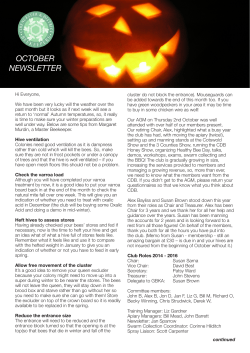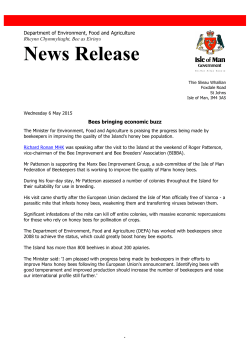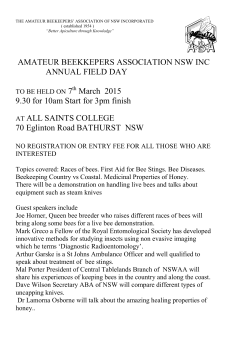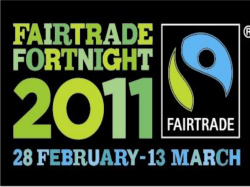
Latest Newsletter - Harrisburg Estates
HARRISBURG VIEWS July 2015 Board Report Summer is finally here and it’s going to get warmer. Glad you are cooling off in the swimming pool. We have to count our blessing as many areas are restricting pools and lawns to save on water. The day may come when we will have to remove our lawn and replace with desert landscaping. I hope that day never comes but until then we need to plan ahead. On a brighter note everyone had a great time celebrating Father’s Day and enjoying the free ice cream at the clubhouse. I saw some newbies and a lot of old friends there. I hope you all make sure your neighbors are aware of the activities we have at the clubhouse for them. Be sure and check the newspaper and our bulletin boards for what’s happening during the month. A big “Thank you” goes out to Myrna and her helpers for keeping the activities going during the Summer Months. Thanks to Kathy Petersen for keeping the water aerobics going for everyone too. We had a water break over the weekend and I really appreciate Warren and all who helped to find the break and fix it. I hope no one had any problems while the water was off but they did a very quick job fixing it. Thanks everyone! Our clubhouse got the final stucco finish and a lot of you “Snowbirds” will be in for a treat when you return to Harrisburg. The clubhouse looks beautiful. A big “Thank you” also to all the volunteers that worked for hours dedicating their time to get the project finished. There have been several sightings of Rattle Snakes in driveways and on properties in the park. Please be aware, protect your pets, use a flashlight at night and watch where you walk. They are not just in the hills!! I look forward to seeing all of you at the regular bi-monthly Board Meeting on the 18th of this month at 10:00 AM. Respectfully, Donna Jo Judson, Vice President HEOA INSIDE THIS ISSUE 2 Treasurer’s Report 2 Pool Security 3 Did you Know? Dino Lady 3 Maintenance Report 5 Welcome to Snake Country 7 New Facts About Bees Harrisburg Views 1 Treasurer’s Report By Sue Brooks Wayne Haslem July 9 Gerald Ciccanti July 11 Mitzi Sharp July 13 Ed Bunch July 16 Beverly Macari July 16 Myrna Holmstead July 18 Olive Louderbough July 18 John Nowak July 23 John Kilpack July 24 Bill Judson July 26 Douglas Boone July 28 Balances as of May 31, 2015 Operating(checking) Account Payroll Account Town & Country CD’S Village/Cache Bank CD’s Wells Fargo Bank Petty Cash Committee Accounts: Activity Committee Harrisburg Improvement Harrisburg Views TOTAL $ 40,824.71 $ 7,670.67 $ 54,055.46 $ 76,572.23 $ 68,916.64 $ 146.00 $ 1,536.05 $ 1,531.31 $ 874.97 $252,128.04 SWIMMING POOL SECURITY Please do not open the pool gate for people you do not know. We continue to have people use the pool that are not homeowners. Anyone entering the pool or clubhouse must have a key and you should not let them in if they do not have a key. Guests need to be accompanied by the homeowner. Children must be accompanied by an adult. Children under 5 are not allowed in the hot tub!! if more than 2 people are in the pool floats are not allowed. For the safety and security of our pool and clubhouse please adhere to these rules. Sue Brooks, HEOA Board of Directors Harrisburg Views 2 Maintenance Report By Steve Anderson Did You Know?? Article by Dino Lady For those who hike or spend any time in our great outdoors, crypto biotic soil crusts are everywhere in this desert environment. Crypto biotic soils look like bacteria condo villages! These crusts consist of cyanobacteria, lichens, and mosses which increase the stability of the easily eroded soils such as sand and provide a system of water infiltration through their sticky secretions which increase soil fertility. Plants growing on crusted soils often show higher concentrations of nutrients. Walking by hikers, cattle, and other animals and off road vehicle tires easily destroy the crust. Formation of the crusts in desert areas can take 5,000 to 10,000 years to form. The Cyanobacteria in these crusts are blue green algae and perform photosynthesis or the transformation of carbon dioxide and energy from the sun into usable oxygen and natural sugars. The discovery of bacteria or microbes happened by accident in 1671 when Anton van Leeuwenhoek, a Dutch fabric maker, noticed moving organisms in old pepper water through a Venetian glass device he fashioned to improve his vision. His later and improved microscope instruments could magnify microbes more than 200 times which was more than the microscope developed by Galileo. It took a while but the full on heat of summer is here. Still trying to balance water conservation with trying not to have the place dry up and blow away. That is most of what's happening at the moment. View our Newspaper Online and in Color at Harrisburg Estates Website: http://www.harrisburgestates.com Committee Members: Marlene Stephenson David Gibbs Kathy Petersen Contact: Marlene Stephenson, Editor hvnews@harrisburgestates.com Don’t forget to mention to our advertisers when you visit that we appreciate them – let them know that we are supporting their business. The significance of bacteria or microbes is that they are the oldest self-replicating organisms on the planet and have the ability to keep this earth healthy or make larger living organisms, such as humans, very ill. Microbes or bacteria are one of the most abundant life forms on earth. Sources available Harrisburg Views 3 Harrisburg Views 4 WELCOME TO SNAKE COUNTRY Article by Marlene Stephenson I went out to move my car across the street a couple of weeks ago and as I got out of my car there was a rattlesnake in my driveway. The snake was under my car in the drive when I got in my car. Thankfully I was not bitten by the snake when I got into my car. There has been several siting of rattlesnakes in our area over the last few months. I have always thought of the snakes as being up in the hills but I realized that we have moved into their home. This prompted me to write a few things that I hope are helpful if you encounter a snake on your property. If you can’t tell if the snake is venomous from a distance, leave it alone and treat it as if it were venomous. Any snake may respond aggressively if agitated. Snakes hibernate during the winter under rocks and in burrows. In the summer they are most active at dawn and dusk. Snakes mainly eat rodents, birds and other reptiles. Never try to poke, handle, corner or harass a snake. Snake bites occur when people are trying to handle or kill the snake. Snakes hide well on open trails and in dense grasses. Be aware of your surroundings. Look carefully where you place your feet, and before you sit down on the ground, on rocks, or on logs. Wear closed-toed shoes while hiking. If you hear a rattle, don’t jump or panic. Try to locate where the sound is coming from before trying to move. Warn others if they are around. If you are bitten do not use a tourniquet or cold compress. Do not suck out the venom. Keep calm, remove restrictive clothing and jewelry near the bite, and keep the affected area below the level of the heart. Treat for shock if necessary and get medical attention immediately. If you do not know if the snake is venomous, act as if it were and do not attempt to trap and move the snake yourself. In the case of venomous snakes, this should be done only by trained personnel from reputable wildlife removal companies or personnel from the Utah Division of Wildlife Resources or USDA Wildlife Services. DO NOT TRY TO MOVE THE SNAKE YOURSELF. HARRISBURG VIEWS 5 Bee on Mesquite Tree in Park Craft Day – Classes 3rd Wednesday of Every Month – Call Myrna Holmstead 435-879-2939 HARRISBURG VIEWS 6 NEAT FACTS ABOUT BEES ARTICLE BY M ARLENE STEPHENSON There are three kinds of bees in a hive: Queen, Worker and Drone. Only the Queen in the hive lays eggs. The queen will lay around 1,500 eggs per day. The worker bees are all female and they do all the work for the hive. Workers perform the following tasks inside the hive as a House Bee: Cleaning, feeding the baby bees, feeding and taking care of the queen, packing pollen and nectar into cells, capping cells, building and repairing honeycombs, fanning to cool the hive and guarding the hive. Workers perform the following tasks outside the hive as Field Bees: Gathering nectar and pollen from flowers, collecting water and a sticky substance called propolis. Bees have two stomachs - one stomach for eating and the other special stomach is for storing nectar collected from flowers or water so that they can carry it back to their hive. The male bees in the hive are called drones. Their job in the hive is to find a queen to mate with. Male bees fly out and meet in special drone congregation areas where they hope to meet a queen. Male drone bees don't have a stinger. If a worker bee uses her stinger, she will die. Bees have five eyes. The bees use their honeycomb cells to raise their babies in, and to store nectar, honey, pollen and water. Nectar is a sweet watery substance that the bees gather. After they process the nectar in their stomach they regurgitate it into the honeycomb cells. Then they fan with their wings to remove excess moisture. The final result is honey. Bees are the only insect in the world that makes food that humans can eat. Honey has natural preservatives bacteria can't grow in it. Honey was found in the tombs in Egypt and it was still edible! Bees have been here around 30 million years. Bees have straw-like tongues called a proboscis so they can suck up liquids and also mandibles so they can chew. Bees carry pollen on their hind legs called a pollen basket. Pollen is a source of protein for the hive and is needed to feed to the baby bees to help them grow. A beehive in summer can have as many as 50,000 to 80,000 bees. A bee must collect nectar from about 2 million flowers to make 1 pound of honey. It requires 556 worker bees to gather a pound of honey. Bees fly more than once around the world to gather a pound of honey. The average worker bee makes about 1/12th of a teaspoon of honey in her lifetime. Every 3rd mouthful of food is produced by bees pollinating crops. Flowering plants rely on bees for pollination so that they can produce fruit and seeds. Without bees pollinating these plants, there would not be very many fruits or vegetables to eat. A single beehive can make more than 100 pounds (45 kg) of extra honey. The beekeeper only harvests the extra honey made by the bees. The average life of a honey bee during the working season is about three to six weeks. There are five products that come from the hive: Honey, beeswax, pollen, propolis, and royal jelly. Beeswax is produced by the bees. Bees have special glands on their stomach that secrete the wax into little wax pockets on their stomach. The bee takes the wax and chews it with her mandibles and shapes it to make honeycomb. Propolis is a sticky substance that bees collect from the buds of trees. Bees use propolis to weatherproof their hive against drafts or in spots where rain might leak in. People have discovered the anti-bacterial properties of propolis for use in the medical field. Royal Jelly is a milky substance produced in a special gland in the worker bee's head. For her whole life the Queen is fed Royal Jelly by the workers. HARRISBURG VIEWS 7 JULY 2015 Sun 5 12 19 Ice Cream Social 6:30 26 Mon Tue Wed Thu Fri 1 2 3 Water Aerobics 9:00AM Water Aerobics 9:00AM Water Aerobics 9:00AM 10 Sat 4 Hot Dog Dinner 4:30 PM 6 Water Aerobics 9:00AM Hand & Foot 6:30 PM 7 8 9 Water Aerobics 9:00AM Water Aerobics 9:00AM Water Aerobics 9:00AM 13 Water Aerobics 9:00AM Hand & Foot 6:30 PM 14 15 16 Activity Meeting 10:00 AM 17 Water Aerobics 9:00AM Water Aerobics 9:00AM Water Aerobics 9:00AM Board Meeting 10:00AM 20 Water Aerobics 9:00AM Hand & Foot 6:30 PM 21 22 Water Aerobics 9:00AM Crafts 1:00 PM 23 24 25 Water Aerobics 9:00AM Water Aerobics 9:00AM 27 Water Aerobics 9:00AM Hand & Foot 6:30 PM 28 29 30 31 Water Aerobics 9:00AM Water Aerobics 9:00AM Water Aerobics 9:00AM Water Aerobics 9:00AM Water Aerobics 9:00AM Pot Luck @ 5:30 PM Water Aerobics 9:00AM 11 Water Aerobics 9:00AM 18 A swarm of bees in May Is worth a load of hay; A swarm of bees in June Is worth a silver spoon; A swarm of bees in July Is not worth a fly. -An Old English Ditty Harrisburg Views 8
© Copyright 2025









